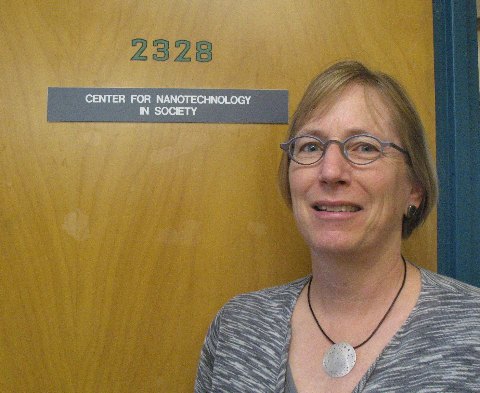The Blessings and Curses of Nanotechnology
A Q&A with Barbara Harthorn, Head of UCSB's Center for Nanotechnology in Society

As the head of UCSB’s Center for Nanotechnology in Society (CNS), Barbara Harthorn has spent the past eight-plus years leading a team of researchers in studying people’s perceptions of the small-scale science with big-scale implications. Sponsored by the National Science Foundation, CNS enjoys national and worldwide recognition for the social science lens it holds up to physical and life sciences.
For some perspective, a nanometer clocks in at about one-billionth of a meter — and the thickness of a piece of paper is a whopping 100,000 nanometers. As tiny as the units are, their applications are growing increasingly popular.
Earlier this year, Harthorn attended a meeting hosted by the Presidential Commission for the Study of Bioethical Issues. The commission’s chief focus was on the intersection of ethics and brain research, but Harthorn was invited to share her thoughts on the relationship between ethics and nanotechnology. A few days after her testimony, Harthorn — who also teaches anthropology at UCSB — spoke with The Santa Barbara Independent about what opportunities nanotechnology pushes forward and what challenges it creates in making sure those opportunities don’t cross the ethical line. Below is an edited version of our conversation.
What are some common uses of manufactured nanomaterials? In the health industry, there is a huge array of applications, including cosmetics, skin products, and sunscreens. CNS started in January 2006; at that point, the largest number of patents in the world was held by L’Oreal. The nanoscale forms of metal oxides have different optical properties, making them very attractive for use in cosmetics.
In what other areas are they commonly found? The automotive industry has a bunch of implications, as does the aerospace industry. They’re using them in building materials. There are nano-additives for concrete to make concrete stronger. There is controversy about nano-silver — bulk silver is an anti-microbial — so people are using nano forms of silver as an anti-bacterial coating. It is being used in hospitals, offering the promise of potentially killing current drug-resistant forms of bacteria. But they are very powerful, and there is a lot of concern about the potential for generating new super-bugs, if used haphazardly.
At CNS, we have looked at the global supply chain of teddy bears that have [nano-silver particles]. They are spread onto the surface of the teddy bear that is presumably for use by an infant and conveys the whole idea of super safety but super hazard. Samsung put it in washing machines, which produced a regulatory action, and Samsung had to treat it as a pesticide. If you buy anti-microbial socks, those could have nano-silver particles. There aren’t a lot of reasons to think there is harm of [skin transfer] by the person wearing the socks but when you wash the socks, the particles aren’t bound into the textile in a chemical way and can go down the drain and enter the water treatment system.
So there are some environmental concerns with nanomaterials. What are the ethical concerns? What came across at the Presidential Commission meeting? They’re talking about treatment of Alzheimer’s and neurological brain disorders, where the issue of loss of self is a fairly integral part of the disease. There are complicated issues about patients’ decision-making. Nanomaterials could be used to grow new tissues and potentially new organs in the future.
What could that mean for us? Human enhancement is very interesting. It provokes really fascinating discussions. In our view, the discussions are not much at all about the technologies but very much about the social implications. People feel enthusiastic initially, but when reflecting, the issues of equitable access and justice immediately rise to the surface. We [at CNS] are talking about imagined futures and trying to get at the moral and ethical sort of citizen ideas about the risks and benefits of such technologies. Before they are in the marketplace, [the goal is to] understand and find a way to integrate the public’s ideas in the development process.
Are there equity issues at stake? It’s about the benefits from investing in this research development and what society will get out of it. Does it mean high-tech jobs that mean the loss of jobs to others? Is public money being used to invest in the research? Should the public be involved in the decision-making, or only as consumers? How do people make sense of new technologies?
We’ve been concerned about ways to accelerate inequality, meaning that enhancements could be distributed to create a new class of the nano-enabled. A lot of the concern has really been how to have both, have the economic development without sacrificing environmental safety, human health, and progress that isn’t just a small subset of the society making more money but actual societal progress to further the public’s goals and needs.



